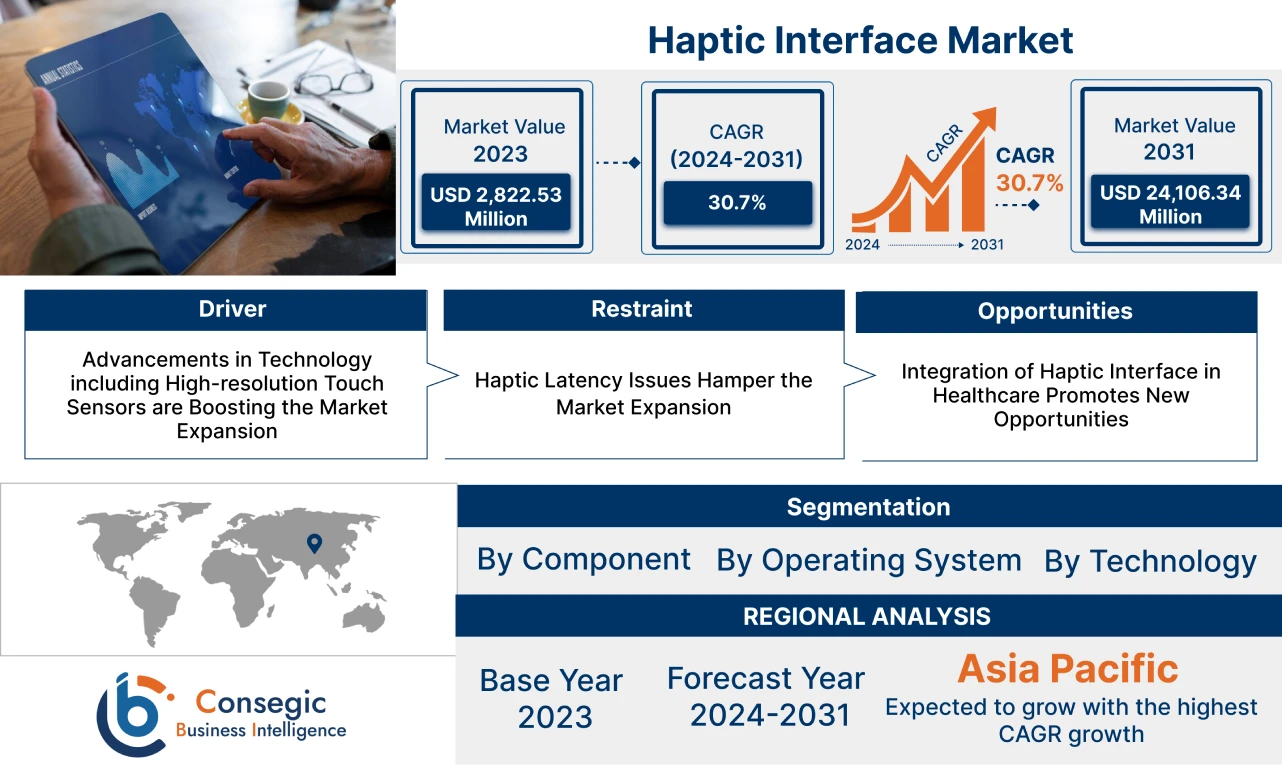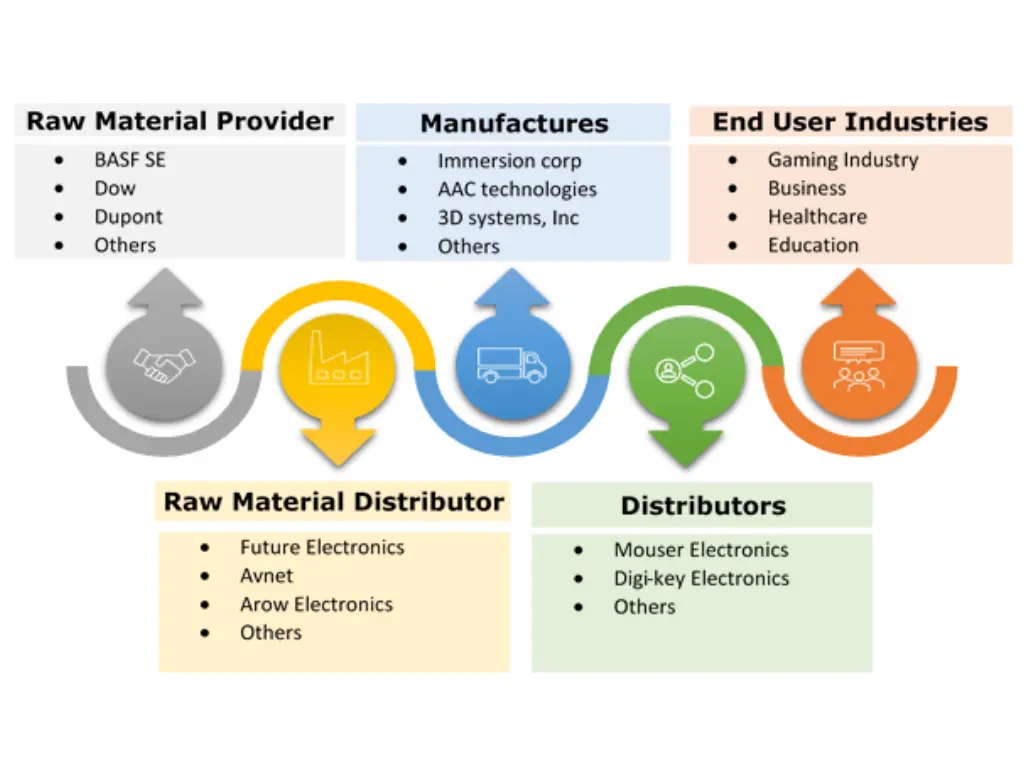Haptic Interface Market Size:
Haptic Interface Market size is estimated to reach over USD 30,771.72 Million by 2032 from a value of USD 3,622.38 Million in 2024 and is projected to grow by USD 4,668.46 Million in 2025, growing at a CAGR of 30.70% from 2025 to 2032.
Haptic Interface Market Scope & Overview:
A haptic interface is a technology that enables manual interaction with virtual environments (VE's) or tele-operated remote systems. The device receives motor action commands from the user and displays appropriate tactual images. It constitutes computer keyboards, mouse, trackballs, gloves, exoskeletons that track hand postures, and joysticks. These devices provide various advantages including enhanced user experience by providing intuitive and engaging interaction, sensations for the 3D model, improved precision and control, realism and immersion in gameplay, training, and others. The aforementioned benefits are major determinants for increasing their adoption in healthcare, virtual reality, gaming, robotics, automotive, art, entertainment, and other industries.
Haptic Interface Market Insights :
Haptic Interface Market Dynamics - (DRO) :
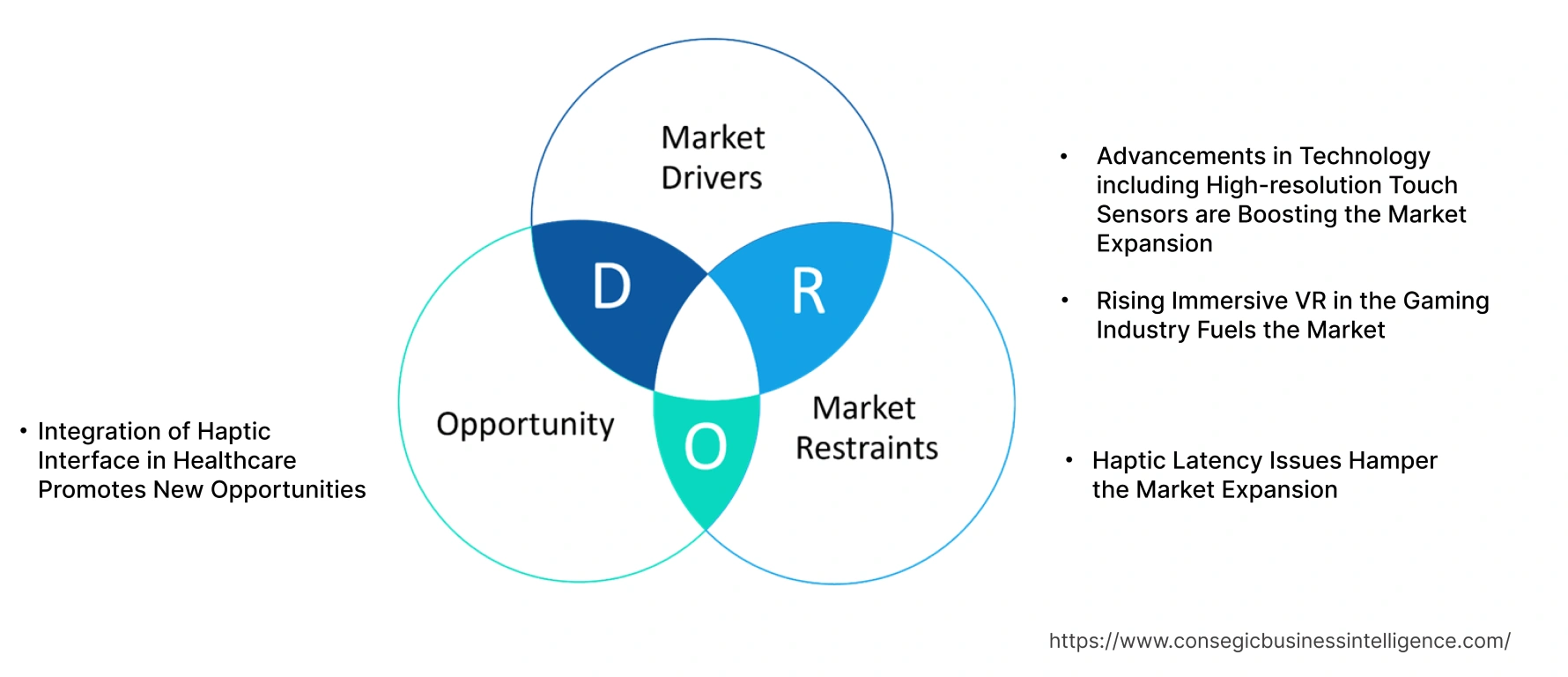
Key Drivers:
Advancements in Technology including High-resolution Touch Sensors are Boosting the Market Expansion
High-resolution touch sensors provide precise and responsive feedback, allowing users to interact with digital devices more intuitively. Additionally, tactile feedback systems, such as vibrations and force feedback, enhance immersion in virtual experience in gaming and virtual reality. Furthermore, wearable devices, automotive touchscreens, and industrial robotics also benefit from technological advancements in the haptic system.
- In August 2022, Samsung Electronics published a paper titled "Actuating Compact Wearable Augmented Reality Devices by Multifunctional Artificial Muscle", in partnership with Ajou University's team of Mechanical Engineering. Researchers have developed a lightweight artificial muscle actuator and sensors for AR glasses and haptic gloves, integrated with wearable devices to enhance immersion in virtual experience by providing advanced sensory features.
Therefore, advancements in technology including high-resolution sensors collectively drive the haptic interface industry.
Rising Immersive VR in the Gaming Industry Fuels the Market
Demand for immersive virtual reality in gaming is a significant driver for the haptic interface market. As users increasingly seek more engaging and realistic interactions within virtual environments, the need for advanced haptic technology becomes paramount. Additionally, gamers seek immersive and realistic experiences, haptic technology enhances gameplay by providing tactile feedback, allowing users to interact within the game.
Factors contributing are tactile sensation, immersive gaming experience, engagement, and personalization. Moreover, these interfaces are widely used in consumer electronics devices such as smartphones, smart wearables, and gaming consoles, providing vibration-based notifications and typing effects to users.
- In January 2022, Sony launched the DualSense Edge wireless controller , offering various customization options to enable users to adopt controllers to tailor individual comfort levels, including button remapping, adjusting stick sensitivity and triggers, switching between different control profiles, and a special on-controller when connected with PS5 enhances the gaming experience.
Hence, the rising demand for immersive VR in games is proliferating in the market.
Key Restraints :
Haptic Latency Issues Hamper the Market Expansion
Haptic latency refers to the delay between the user input and the corresponding haptic feedback, and even a minor delay leads to an unsatisfactory user experience, particularly in VR, AR, and gaming. High latency causes a disconnect between the user's action and the feedback received. This reduces the overall effectiveness and immersion of haptic technology. Moreover, network latency also contributes to high haptic latency due to slow response and reduced accuracy in gaming, healthcare, and others.
- According to the analysis of Immersion Corp, the maximum latency of 225 milliseconds (ms) significantly slowed the task by 64% from the reference condition of 8 ms delay. Additionally, in online gaming, network latencies of more than 100 ms caused a significant reduction in player accuracy and performance, affecting user experience.
Consequently, haptic latency is impeding the adoption of haptic technologies across various industries.
Future Opportunities :
Integration of Haptic Interface in Healthcare Promotes New Opportunities
Haptic technology can revolutionize how medical professionals learn and practice procedures by providing realistic tactile feedback and enhancing the effectiveness of medical training programs and surgical simulations. Additionally, advancements in haptic technology can lead to the development of more sophisticated medical devices and tools that offer enhanced tactile feedback for precise diagnostics and procedures. Factors driving the utilization of haptic technology in healthcare include integration with existing systems, customization, adaptability, safety, hygiene, and enhanced user experience. Furthermore, the increasing investments in healthcare are also expected to drive the market during the forecast period.
- In November 2023, according to the analysis of the National Institute of Health ,immersive technologies including virtual reality (VR), augmented reality (AR), mixed reality (MR), haptic rendering and tracking, which simulates the sense of touch and force feedback in surgical simulations to enhance surgical skills.
The integration of haptic technology in healthcare is expected to be transformative for the haptic interface market during the forecast period.
Haptic Interface Market Segmental Analysis :
By Component:
Based on the component, the market is bifurcated into hardware and software.
Trends in the haptic interface component
- Manufacturers are increasingly incorporating haptic feedback in consumer electronics including smartphones, tablets, and wearables, to enhance user experience and improve device interactivity.
- Software platforms enable users to experience tailored haptic feedback, allowing for customization and flexibility in haptic feedback.
The hardware segment accounted for the highest haptic interface market share in 2024.
- Hardware-based haptic interface comprises physical components including actuators, sensors, and controllers that play a crucial role in delivering haptic feedback.
- The need for advanced haptic technology in various applications including gaming, automotive, medical, and industrial sectors has driven the expansion of the hardware segment.
- Haptic sensors are used to gather data about users' interaction with the device and environment. Additionally, actuators are used for the generation of vibrations, forces, or motion to create tactile feedback.
- In August 2022, D-BOX Technologies Inc. launched a new generation of patented haptic technology actuator system called the G5 system responsible for the generation of movement, texture, and vibrations in gaming systems.
- Thus, the utilization of the aforementioned hardware components to produce a haptic effect is driving the proliferation of the haptic interface market.
The software segment is anticipated to emerge as the fastest-growing segment during the forecast period.
- Software systems including algorithms and haptic programming play a vital role in managing the response generated by haptic technology.
- Haptic software is responsible for gathering and processing the data received by different hardware components.
- Additionally, TouchSense software allows developers to create highly customized haptic experiences to enhance user experience.
- On May 11, 2021, Immersion Corporation partnered with Panasonic Mobile Communications Co.Ltd to incorporate TouchSense software and haptic technologies in Panasonic mobile devices.
- Consequently, the ability of software systems to facilitate efficient communication between hardware components is accelerating the haptic interface market opportunities.
By Technology:
Based on technology, the market is segmented into Kinesthetic feedback, Tactile feedback, Vibrotactile feedback, Force feedback, and others.
Trends in the haptic feedback technology
- Wearable devices, such as smartwatches and fitness trackers, use haptic feedback for notifications and alerts, innovations in wearable haptics aim for better comfort and battery efficiency
- Tactile feedback is crucial for immersive experiences in virtual reality (VR) and augmented reality (AR). Developers are focusing on creating precise and context-aware sensations to enhance realism.
The tactile feedback segment accounted for the largest revenue share in the year 2024.
- Tactile feedback refers to the use of touch sensations to communicate information to a user, this sensory input can include vibrations, pressure, or texture changes that simulate the sensation of real-world interactions.
- They offer a wide range of benefits including enhanced user experience, confirmation and alerts, navigation and gaming, accessibility, and others.
- It's commonly used in devices like smartphones, tablets, and car navigation systems to enhance accuracy and user satisfaction.
- In February 2022, Elobau launched a vibration module, to engage machine and vehicle manufacturers with operators' tactile sensory systems. The module is designed to work with the Heavy-duty joystick J4F and midi modular armrest 225MA. The module is incorporated into the multi-function handles 361G/362G and 341G/342G.
- Thus, the market analysis concludes that the tactile feedback segment is driving the haptic interface market share.
The force feedback segment is anticipated to register the fastest CAGR growth during the forecast period.
- Force feedback is a technology that replicates the tactile sensations and force that the user senses when interacting with a device, typically in response to actions.
- They provide a variety of advantages including enhanced user experience, improved accuracy and control, real-time feedback, increased safety, and training effectiveness.
- It is most often used in gaming, virtual reality, medical simulations, automotive industries, robotics, and others.
- In September 2022, Logitech launched PRO Racing Wheel and PRO Racing Pedals, designed to provide a highly realistic and engaging racing experience, including a high-performance direct drive engine and force feedback technology for a precise and authentic racing connection.
- Hence, rising innovation in force feedback haptic technology is anticipated to boost haptic interface market trends.
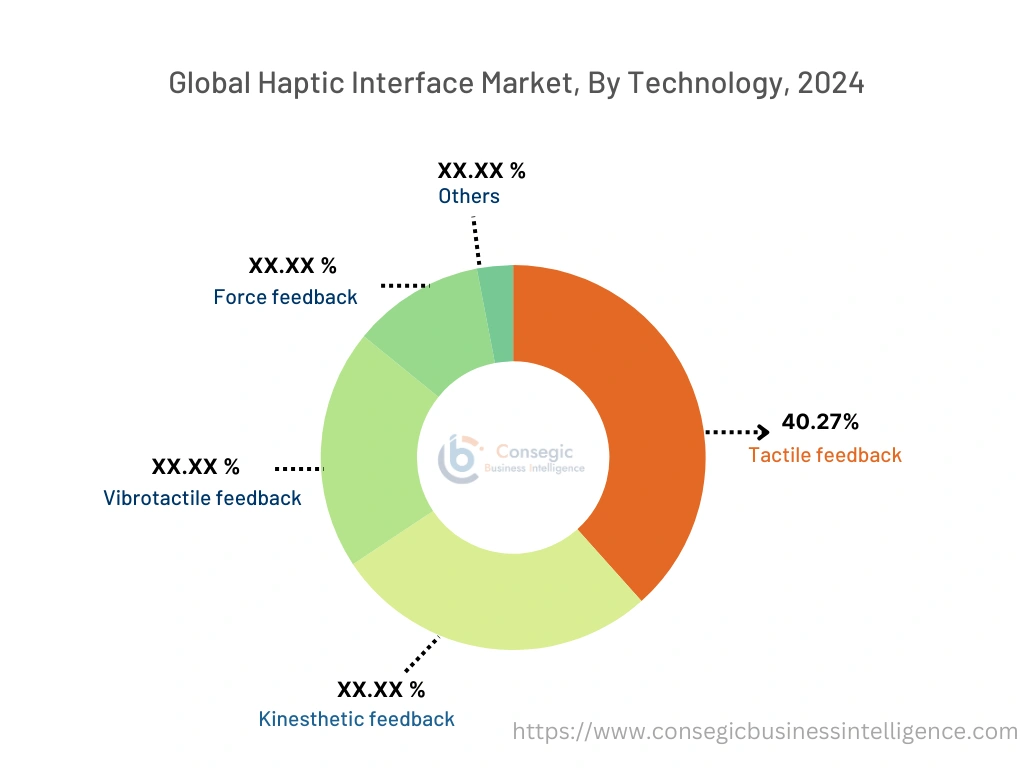
By Operating System:
Based on the operating system, the market is segmented into Windows and Mobile OS.
Trends in haptic interface operating system
- Operating systems are increasingly supporting VR and AR applications to leverage haptic feedback, to enhance immersion and interactivity in virtual environments.
- The rise in development tools and software development kits (SDK) that support haptic feedback across both operating systems, enabling developers to create consistent haptic experiences across different devices and operating systems.
The mobile OS segment accounted for the largest revenue share in the year 2024 and is expected to register the fastest CAGR growth during the forecast period.
- Haptic technology on mobile operating systems including Android and iOS provide tactile feedback to enhance user experience on smartphones and tablets.
- Manufacturers are providing customized vibratory patterns in response to users' actions or events. Additionally, haptic feedback is implemented in various Android applications, games, and features.
- For instance, in May 2023, Cambridge Mechatronics Ltd. collaborated with SMA-Tech for the mass production of haptic actuators for products including smartphones and wearables.
- Hence, the mobile OS segment is propelling and is expected to expand the haptic interface market demand.
By End User:
Based on the end user, the market is segmented into individuals, gamers, students, healthcare, designers, businesses, robotics, and others.
Trends in haptic interface end-use
- The increasing need for immersive gaming experiences and advanced VR/AR applications is driving the adoption of haptic technology.
- Growing reliance on realistic medical simulations for training purposes is pushing the development and integration of sophisticated haptic technology systems.
- The rise of automation and remote operations in industrial settings is increasing the demand for haptic technology systems to improve control and accuracy.
The gamers segment accounted for the largest revenue share in the year 2024.
- Gamers seek enhanced immersion and realism in the gameplay, driving the need for advanced VR haptic technology that offers interactive, and engaging environments.
- Determinants including increasing demand for immersive gaming experiences, advancements in VR game development with high-quality graphics, the latest sensory feature, enhanced tracking, and growing popularity of e-sports and virtual reality competitions are key aspects driving the expansion of the Gamers segment.
- In February 2023, Sony Interactive Entertainment launched a virtual reality headset PlayStation VR2 headset and included a PlayStation VR2 Sense controller with haptic feedback, featuring high-fidelity visuals, enhanced tracking, and enabling users to experience a heightened range of sensations.
- Consequently, as per the market analysis the gaming segment is driving the haptic interface market trends.
The business segment is anticipated to register the fastest CAGR growth during the forecast period.
- Businesses leverage VR haptic technologies to create realistic scenarios for training purposes, enabling employees to hone skills, follow safety protocols, and develop problem-solving abilities in a controlled environment.
- Factors including enhanced training, precise and responsive feedback, improved remote collaborations, and industrial applications are key aspects driving the opportunities for the business segment.
- According analysis of Meta, 65% of VR users noted improved collaboration during online video meetings, 59% found that VR accelerated hard skills training compared to other e-learning tools and 68% felt a stronger sense of connection with coworkers through VR.
- Therefore, the business segment is anticipated to boost the market trend during the forecast period.
Regional Analysis:
The regions covered are North America, Europe, Asia Pacific, Middle East and Africa, and Latin America.
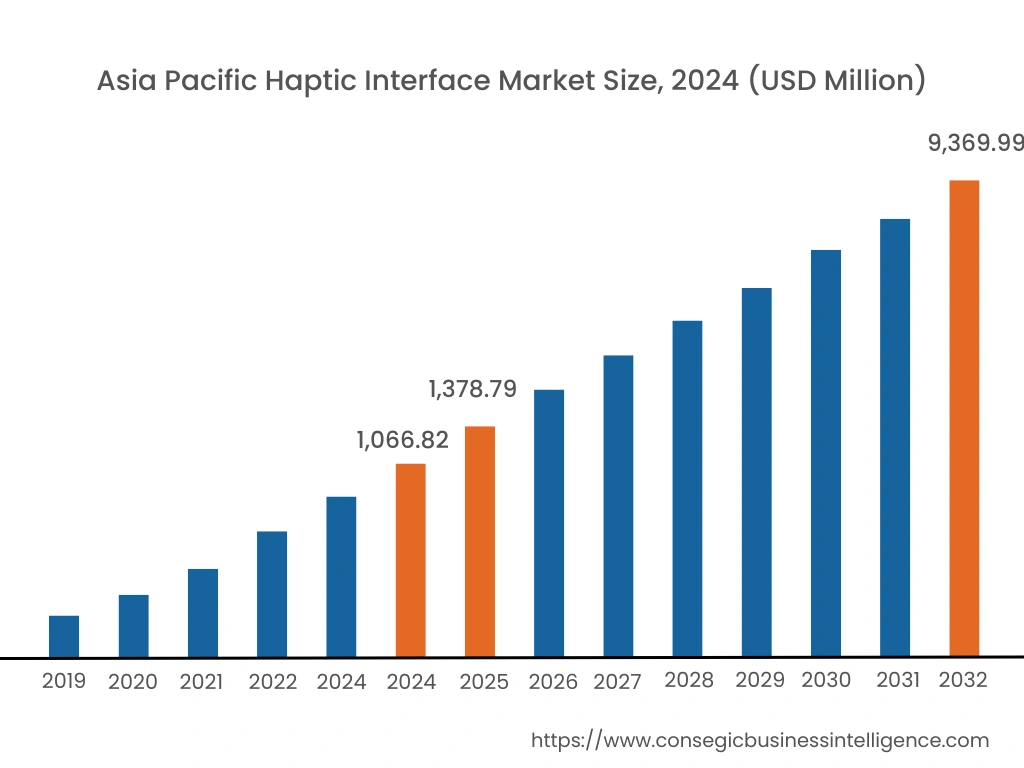
North America is estimated to reach over USD 9,973.11 Million by 2032 from a value of USD 1,201.57 Million in 2024 and is projected to grow by USD 1,545.61 Million in 2025. The market of haptic interface is mainly driven by its deployment in gaming, education, healthcare, businesses, and other industries.
- For instance, Immersion Corporation, headquartered in San Jose, California, a prominent leader in the field of haptic technology collaborated with Kanzi Studio to provide haptic-enabled HMI units for center stack displays and automotive touchscreen.
Furthermore, technological advancements including high-resolution touch sensors, precise and responsive feedback, and a thriving game are expected to fuel market growth in North America in the coming forecast period.
Asia-Pacific region was valued at USD 1,066.82 Million in 2024. Moreover, it is projected to grow by USD 1,378.79 Million in 2025 and reach over USD 9,369.99 Million by 2032. Out of this, China accounted for the maximum revenue share of 33.5%.
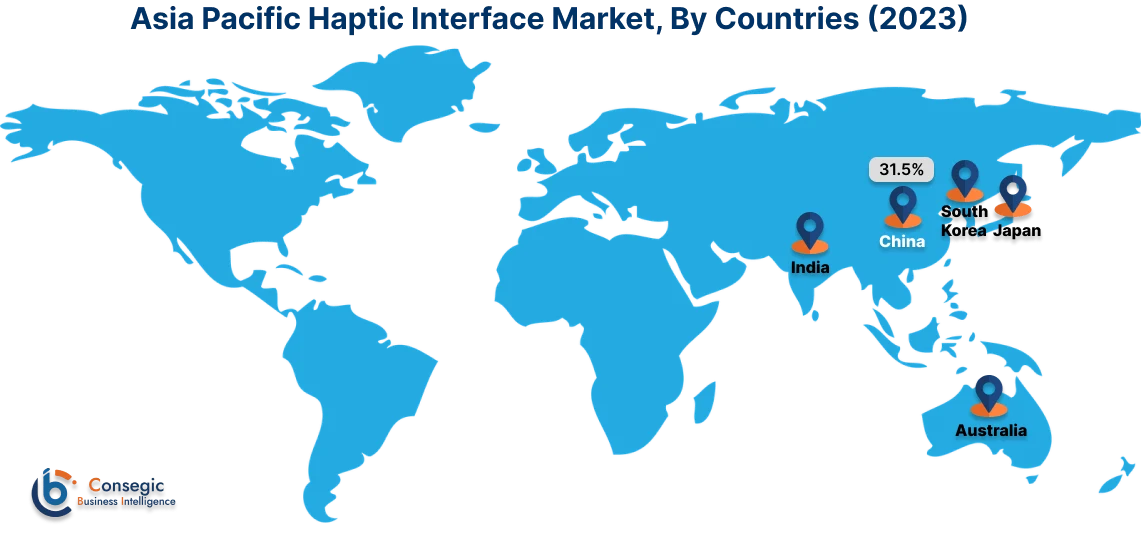
The Asia-Pacific region's growing industrialization and development offer lucrative development prospects for the market trend. Additionally, the evolution of online gaming culture, high smartphone penetration, and large consumer base are driving haptic interface market growth.
- In June 2024, Aqara (Shenzhen, China) launched Aqara Magic Knob V1 featuring AAC technologies haptic solution and a built-in ID with haptic design, allowing for versatile usage scenarios and mimicking the feel of traditional mechanical knobs for a user-friendly experience.
As per haptic interface market analysis, Europe is anticipated to witness substantial growth that is backed by the consumer electronics sector. Companies invest in innovative VR technologies to cater to the surging demand for haptic technology across the region.
The market in the Middle East and Africa is growing due to the expansion of healthcare and automotive industries, as well as increased use of advanced technology. Prominent nations such as the UAE, Saudi Arabia, and South Africa are at the forefront, reaping the rewards of rising investments in technological advancements.
The expansion in Latin America is mainly being fueled by the growth of the automotive and consumer electronics industries. Countries such as Brazil and Argentina are leading the way in this progression, emphasizing technological evolution and investment. Nevertheless, the area experiences difficulties such as financial uncertainty and inadequate infrastructure in certain areas.
Haptic Interface Market Competitive Landscape:
The haptic interface market is highly competitive with major players providing enhanced user experience, realism, and immersion to the national and international markets. Key players are adopting several strategies in research and development (R&D), product innovation, and end-user launches to hold a strong position in the haptic interface market. Key players in the haptic interface industry include-
- 3d Systems, Inc (U.S)
- Immersion Corporation(U.S)
- Haption (France)
- Microchip Technology Inc. (U.S)
- NIDEC Corporation (Japan)
- Texas Instruments Incorporated (U.S)
- AAC Technologies (China)
- Johnson Electric Holdings Limited (Hong Kong)
- ON Semiconductor Corporation (U.S)
- Precision Microdrives Ltd. (U.K)
- SMK Corporation (Japan)
- OFILM (China)
- Synaptics Incorporated (U.S)
Recent Industry Developments :
Product Launches
- In April 2024, Samsung launched Neo QLED 8K and 4K, OLED TVs with smart features of Samsung Tizen OS for enhanced integration and personalization, enabling the utilization of smartphones as gaming devices with a personalized user interface (UI), and haptic feedback, offering convenient and enhanced gameplay.
- In January 2023, Peratech unveiled the FusionPad Haptic Force-Enhanced Trackpad at CES in Las Vegas, to improve the notebook usand er experience by offering various user interactions, including multiple clicks for increased functionality and precise haptic feedback for better control.
Enhancement in Existing Product
- In May 2024, Apple introduced features including eye tracking for users with physical disabilities to control iPad or iPhone with their eyes. Additionally, music haptics will offer a new way for users who are deaf or hard of hearing to experience music using the Taptic engine in the iPhone.
- In July 2023, PlayStation5 system software was designed to enhance the gaming experience, allowing users to activate haptic feedback effects when using the DualSense Controller, DualSense Edge Controller, or PS VR2 Sense controller while navigating the PS5.
Business Expansions
- In May 2024, Immersion Corporation signed a license with Meta Platforms, Inc. to provide access to Immersion's patent for Meta and affiliates' hardware, software, VR, and gaming products.
Haptic Interface Market Report Insights :
| Report Attributes | Report Details |
| Study Timeline | 2018-2031 |
| Market Size in 2031 | USD 24,106.34 Million |
| CAGR (2024-2031) | 30.7% |
| By Component |
|
| By Operating System |
|
| By End User |
|
| By Region |
|
| Key Players |
|
| North America | U.S. Canada Mexico |
| Europe | U.K. Germany France Spain Italy Russia Benelux Rest of Europe |
| APAC | China South Korea Japan India Australia ASEAN Rest of Asia-Pacific |
| Middle East and Africa | GCC Turkey South Africa Rest of MEA |
| LATAM | Brazil Argentina Chile Rest of LATAM |
| Report Coverage |
|
Key Questions Answered in the Report
How big is the haptic interface market? +
Haptic Interface Market size is estimated to reach over USD 30,771.72 Million by 2032 from a value of USD 3,622.38 Million in 2024 and is projected to grow by USD 4,668.46 Million in 2025, growing at a CAGR of 30.70% from 2025 to 2032.
What specific segmentation details are covered in the haptic interface report, and how is the dominating segment impacting the market growth? +
For instance, by type segment has witnessed transistors as the dominating segment in the year 2024, businesses leverage VR haptic interfaces to create realistic scenarios for training purposes, enabling employees to hone skills, follow safety protocols, problem-solve in a controlled environment, and other industrial applications.
What is the key market trend? +
An emerging trend envisions haptic communication as part of the Internet of Things (IoT), enabling users to remotely feel and manipulate objects, with applications ranging from telemedicine to virtual collaboration.
Who are the major players in the haptic interface market? +
The key players in the haptic interface market include 3d Systems, Inc (U.S), Immersion Corporation (U.S), AAC Technologies (China), Johnson Electric Holdings Limited (Hong Kong), Haption (France), Microchip Technology Inc. (U.S), NIDEC Corporation (Japan), ON Semiconductor Corporation (U.S), Precision Microdrives Ltd. (U.K), SMK Corporation (Japan), OFILM (China), Synaptics Incorporated (U.S), Texas Instruments Incorporated (U.S) and others.
Which region/country is anticipated to witness the highest CAGR during the forecast period, 2025-2032? +
Asia-Pacific is anticipated to register the fastest CAGR growth during the forecast period due to the rapid pace of industrialization, growth of gaming culture, and adoption of VR haptic interfaces in education, healthcare, and others.
